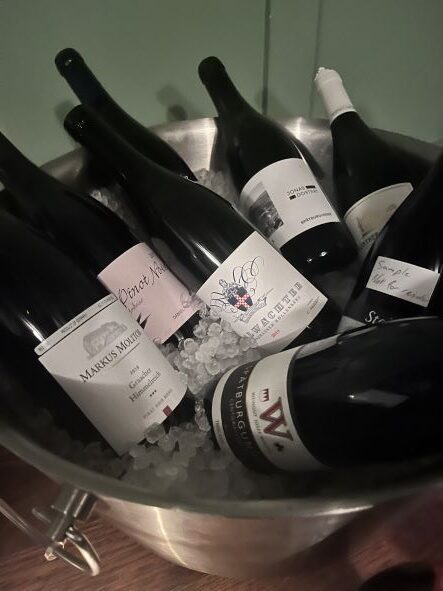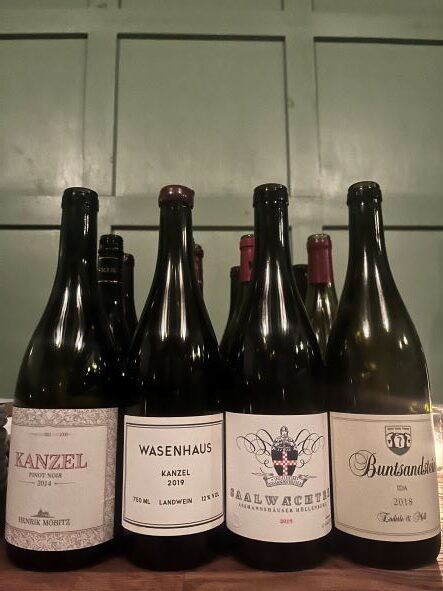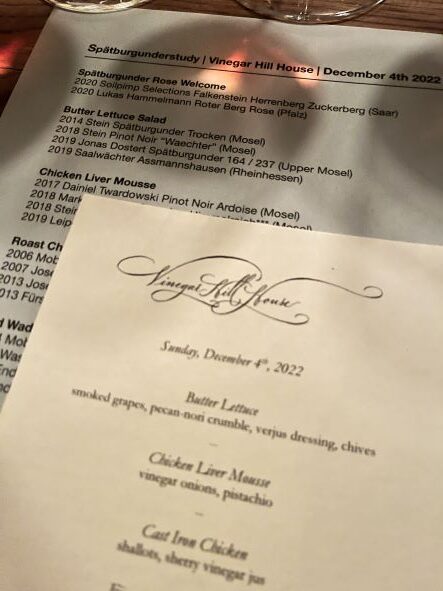“Trouble is, in the United States at least, hardly anybody has tasted it, much less heard of it. Most people don’t even realize that Germany produces any red wine at all, let alone some very good Pinot Noir. Few wine shops carry a selection of Spätburgunders, and even those in on the secret may have only one or two bottles at a time.” – Eric Asimov, New York Times, “Pinot Noir with an Umlaut,” January 11th, 2010
This is one of the many situations regarding German Pinot Noir, called Spätburgunder in German, that has changed dramatically in the last twelve years: People know about German Spätburgunder and it is more available then ever. We are here to help: If you want to try and find any of the wines discussed below, please email orders@vomboden.com and we will do our best to help you find them.
—
In January of 2010 I organized what must have been the first-ever “Spätburgunder Study” with Klaus Peter Keller and Caroline Diel – a good decade or so before Soilpimp would coin the phase! It was a small group of tasters including myself, Klaus Peter Keller, Caroline Diel, Eric Asimov and Soilpimp. We had 19 Spätburgunders from the 2007 vintage; it was an introduction, in a way, for all of the Americans at the table. I worked in retail at the time and certainly had had my fair share of one-off tastings of the top Spätburgunder producers, but I don’t believe I had had the opportunity to really sit down and go a bit deeper into the wines, to taste so many side by side.
I think we all felt the wines showed considerable… how do you say, promise. There were moments of joy and beauty, but I think one of Asimov’s lines from the article he would later write about the dinner maybe summed it up best: “Some of the Spätburgunders indicated a dismaying preference for oakiness and power over purity and finesse.”
 The most profound part of looking back is often the realization of how far you’ve come, how much things have changed. The change, the delicacy and clarity of the wines, the freshness and transparency, from the first tasting to this most recent one was the difference between night and day. Here’s another way to think about how much has changed: Of the 17 estates included in this tasting, six of them – over a third – weren’t even in existence or producing wine when we did the last tasting. Even more incredible in a way: All four of my top wines came from these new estates.
The most profound part of looking back is often the realization of how far you’ve come, how much things have changed. The change, the delicacy and clarity of the wines, the freshness and transparency, from the first tasting to this most recent one was the difference between night and day. Here’s another way to think about how much has changed: Of the 17 estates included in this tasting, six of them – over a third – weren’t even in existence or producing wine when we did the last tasting. Even more incredible in a way: All four of my top wines came from these new estates.
For me, the Spätburgunder Study II, generously and lovingly organized by Soilpimp, was a revelation as well as a shot across the bow: Spätburgunder has arrived.
We tasted 22 wines scattered across eight vintages: Two rosés from 2020, four Späburgunders from 2019, six from 2018, an assortment from 2017, 2015, 2014, 2013 with single bottles from 2007 and 2006. The estates came from Baden (7), Rheingau/Rheinhessen (2), Franken (4), the Pfalz (2) the Mosel (6) and the Saar (1) – the full list is below. Obviously some iconic producers and even one arguably important Spätburgunder region (the Ahr) were not included. We did our best but this was not meant to be comprehensive or encyclopedic or exhausting.
I’ll spare you the detailed, wine-by-wine tastings notes (Zzzzzzzzzz) and rather just touch upon a few bigger picture themes.
Perhaps it’s not really worth mentioning the rosés, except to mention that they were exceptional? The Hofgut Falkenstein “@soilpimp selection” rosé was sharp and cutting: a delicious sucker-punch to the palate. A perfect wake-up call and introduction to the tasting. The 2020 Hammelmann Pinot Noir Roter Berg rosé was simply bonkers. I personally love it when producers go all in on something that they know makes sense for their terroir and style even if they also know the market won’t understand it and maybe won’t support it. But this is a single-vineyard, “Grand Cru,” barreled-over (meaning a 2020 rosé not bottled until the fall) rosé that was only recently released. It’s ambitious and grandiose without being at all heavy or absurd. Honestly I thought it was fucking spectacular and one of the wines of the evening: glossy and even oily with ultra-fragrant perfumed fruit, a slick core of minerality, beautiful finesse and just perfect elegance. A very, very serious wine that just happens to be a rosé.
Other perhaps surprising revelations? Two words: The Mosel.
If Baden is the place you think about when you think about Spätburgunder, and there are a lot of arguments that this should be the case, one of the shocking facts of the night was the prominence and obvious quality from the Mosel. Two of my top three Spätburgunders (not including the Hammelmann Spätburgunder rosé which is in its own unique category) were from the Mosel, a fact that even shocked me. Compared to the wines from Baden, as you’d expect, the Mosel Spätburgunders just had a tighter form, they felt more compact. If sometimes they had a rusticity to them, this rusticity felt like an advantage, like an honest edge to them, or a perhaps the result of a more compact structure still unfurling (in the case of the younger Mosel Spätburgunders). I wonder if some of the isolation of the Mosel, or perhaps some of the financial limitations of the Mosel (it is, comparatively speaking, a rather poor place), kept the more expensive and “luxurious” barrels away from the region, preventing the dominant oak flavors one gets, or at least used to get, in regions like Baden, Franken, the Pfalz and the Rheingau/Rheinhessen.
A mini-vertical (2014, 2015 and 2018) of Stein’s top Spätburgunder, called “Waechter” in honor of Stein’s friend F.K. Waechter, a famous German cartoonist, author and playwright and founder of the Neue Frankfurter Schule, who did the artwork for the label, was impressive. While not wildly complex, the wines were seamless and beautifully unified and the 2014 and 2015 were coming into lovely form. They were just a joy to drink. The 2019 Spätburgunder from the young Jonas Dostert in the limestone Obermosel was a show-stopper: dense and complex, dark-fruited with just so much nuance, detail and structure. This is a region that is going to turn heads in the next decade, there is just no doubt. Dostert’s wine was one of my wines of the night.
 It was a treat to taste two wines from Henrik Möbitz, an insider’s insider-wine if ever there was one. Möbitz made miniscule amounts of wine until, I believe, 2018 when he “retired” to go back to his full-time job which is, as it were, curing cancer, literally. For me Möbitz, along with Enderle & Moll, was among the first to approach Spätburgunder as if it was Pinot Noir and not just another red wine to slather with new wood. Möbitz farmed very interesting parcels of older vines (many of which were handed over to Wasenhaus to begin farming in 2019) and practiced very delicate élevages. The wines had an obvious transparency; they clearly spoke the language of soil when many in Germany where still just looking for ripeness. It was such a pleasure to be able to compare a 2014 Kanzel from Möbitz to a 2019 Kanzel, the same exact parcel, now made by Wasenhaus. Both were superb.
It was a treat to taste two wines from Henrik Möbitz, an insider’s insider-wine if ever there was one. Möbitz made miniscule amounts of wine until, I believe, 2018 when he “retired” to go back to his full-time job which is, as it were, curing cancer, literally. For me Möbitz, along with Enderle & Moll, was among the first to approach Spätburgunder as if it was Pinot Noir and not just another red wine to slather with new wood. Möbitz farmed very interesting parcels of older vines (many of which were handed over to Wasenhaus to begin farming in 2019) and practiced very delicate élevages. The wines had an obvious transparency; they clearly spoke the language of soil when many in Germany where still just looking for ripeness. It was such a pleasure to be able to compare a 2014 Kanzel from Möbitz to a 2019 Kanzel, the same exact parcel, now made by Wasenhaus. Both were superb.
I was excited to taste the wines of Josef Walter which I knew of but hadn’t ever tasted; I thought they were lovely, rustic but very pure and honest. A 2019 Pinot Noir from the young Peter Leipold in Franconia didn’t show as well as I had hoped, but it was lovely and showed his deft touch. A 2015 Keller Frauenberg was cooling and super-elegant. It had been many years since I had checked in on this wine and it didn’t disappoint. I forgot to bring the 2019 Enderle & Moll Pinot Noir “Muschelkalk” which pissed me off, because I think it had the potential to be one of the best on the table. A 2018 Buntsandstein “Ida” was there to represent this estate which I think gets way overlooked these days, and it was awesome, but it’s sometimes a bit too much of a wine for me. I like the structure and cut of the limestone “Muschelkalk.” The young Carsten Saalwächter in Ingelheim (the norther edge of the Rheinhessen) is another rising star. He farms limestone-riddled parcels around his home town, but also farms tiny parcels in the once-legendary Spätburgunder town of Assmanshaus (yes that’s the name of the village, leave me alone). Assmanshaus is in the Rheingau, at the western edge right as the Rhein turns northwest, creating the Middle Rhein. Saalwächter’s Pinot was plush with tremendous force. At the end Soilpimp spontaneously opened a 2020 Lukas Hammelmann Pinot Noir Roter Berg – the red-wine sibling of the rosé which I already discussed. It was sleek and had a beautiful form and poise. Both the Saalwächter and the Hammelmann showed touches of wood that were maybe a bit too prominent for them right now. This is a trend we see with younger growers. The goal for them, however, is not to have the influence of oak, it is to have absolutely top-quality barrels that they condition themselves. Part of this journey, alas, is having to produce a few vintages that show a bit more luxurious than one might want. In both cases, I believe the wines will integrate this and have a great future. Future vintages will benefit. A collector attending was cool enough and generous enough (!) to bring a 2018 Prieure Roch les Clos des Corvées to add a Burgundian flourish to the evening.
At the end of the day though, while I’m loathe to stoke the fire more as I already spend too much of my time dealing with customers pissed off at me regarding their Wasenhaus allos, the 2018 Spätburgunder Möhlin was probably top dog. I mean, faaaawk. There’s my tasting note. I think everyone at the tasting agreed, Wasenhaus lives up to the hype. The wines are detailed and have a clarity, a sort of restrained lavishness that makes them feel exotic while also being buoyed and fresh.
Yes, Wasenhaus is great and impossible to find. You would be well advised to find things that are great and possible to find: Hofgut Falkenstein, Stein, Hammelmann, Steinmetz, Leipold, Josef Walter, Enderle & Moll, Saalwächter are not yet wildly expensive nor are they that hard to get. Explore and indulge now, because this will change.
And here’s perhaps the most relevant note of the evening and it regards pricing, which reflects to some extent Germany’s own deep-dive into Spätburgunder. While the 2010 tasting showcased what was at the time a very rare and elite group – a rare and elite product as it were – the middle has filled in and this is going to be a very fucking fun place to explore for the next few years.
In his 2010 New York Times piece, Asimov quotes the prices for most of the bottles we were tasting at about $70 to $140 retail. I think that’s about right. I’d guess if you’d average all the retail prices of the wines we had last night – a full 12 years later with all the inflation and recent hyper-inflation included – we’d still clock in around $70, with many of them coming in around or even well under $50. As a final calculation, for fun, I added just one more bottle to the equation, the 2018 Prieure Roch. All of a sudden, with only one culty bottle of Burgundy, our average bottle price shot up over 30% to $100. Yup, that’s Burgundy.
Welcome to Spätburgunder.
While vom Boden has enjoyed a relatively open field for the last decade, this too is changing. The entrance into Germany of the Burgundian legend Becky Wasserman – they are now representing the wines of Fürst – is only the most obvious and dramatic sign of the times. As more and more German winemakers have traveled through France, learning, drinking, sharing friendships, a growing segment of the drinking and collecting population is now experiencing German wines, Spätburgunders and beyond, for the first time. It’s only going to accelerate from here. We couldn’t be more excited.
A profound thank you to Soilpimp, who masterminded all of this, including the perfect venue of the legendary Vinegar Hill House in Brooklyn. Honest, delicious cooking with really thoughtfully sourced ingredients – and I might add a killer wine list by the soothsayer Bill Fitch. Go there for the waddle; stay for the German selections.
 * All wines have been listed as Spätburgunder or Pinot Noir as per the producers and labels; another article could be written on how and why certain producers choose which word to use.
* All wines have been listed as Spätburgunder or Pinot Noir as per the producers and labels; another article could be written on how and why certain producers choose which word to use.
Spätburgunder Rosé Welcome
2020 Hofgut Falkenstein “Soilpimp Selection” Herrenberg Rosé
2020 Lukas Hammelmann Pinot Noir Roter Berg Rosé
Flight Eins
2014 Stein Spätburgunder “Waechter”
2015 Stein Spätburgunder “Waechter”
2018 Stein Spätburgunder “Waechter”
2019 Jonas Dostert Spätburgunder
Flight Zwei
2017 Daniel Twardowski Pinot Noix “Ardoise”
2018 Markus Molitor Pinot Noir Himmelreich ***
2018 Stefan Steinmetz Pinot Noir Herrenberg **
2019 Leipold Pinot Noir
Flight Drei
2006 Möbitz Pinot Noir Kapelle
2013 Josef Walter Spätburgunder “J” Centgrafenberg
2013 Fürst Spätburgunder Centgrafenberg GG
2007 Josef Walter Früburgunder “J” Centgrafenberg
Flight Vier
2014 Möbitz Pinot Noir Kanzel
2019 Wasenhaus Spätburgunder Kanzel
2019 Saalwächter Pinot Noir Höllenberg
2018 Enderle & Moll Spätburgunder “Buntsandstein Ida”
Flight Fünf
2015 Keller Spätburgunder Frauenberg 2015
2019 Ziereisen Spätburgunder “Rhinis”
2018 Dr. Heger Spätburgunder Schlossberg GG
2018 Wasenhaus Spätburgunder Möhlin
Riesling Reset
2021 Stein Riesling Palmberg “Alte Reben” Kabinett Trocken!
Nur Spass zu Machen!
2020 Lukas Hammelmann Pinot Noir Roter Berg
2018 Prieure Roch “Le Clos des Corvées”